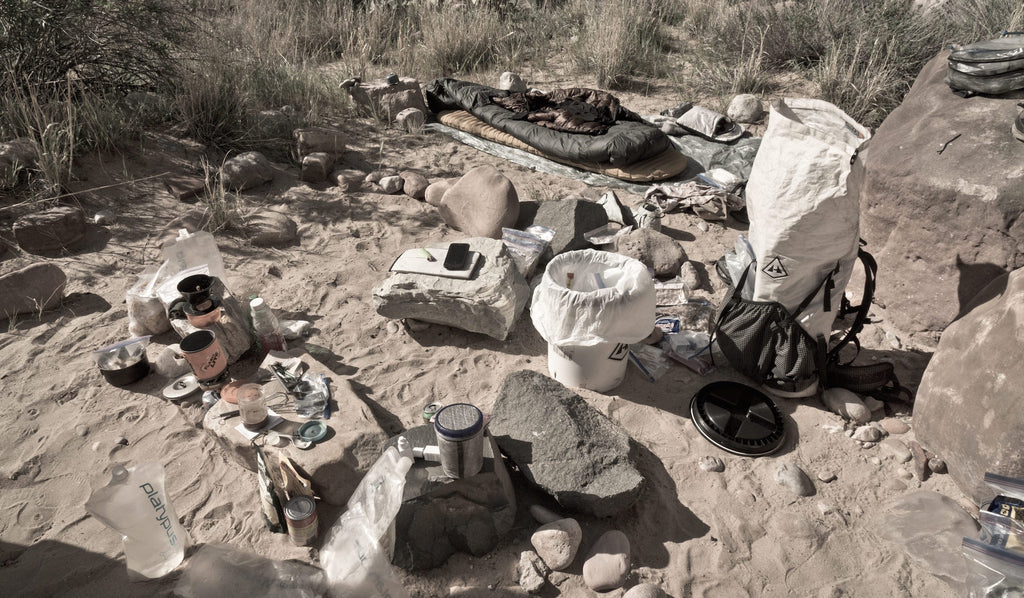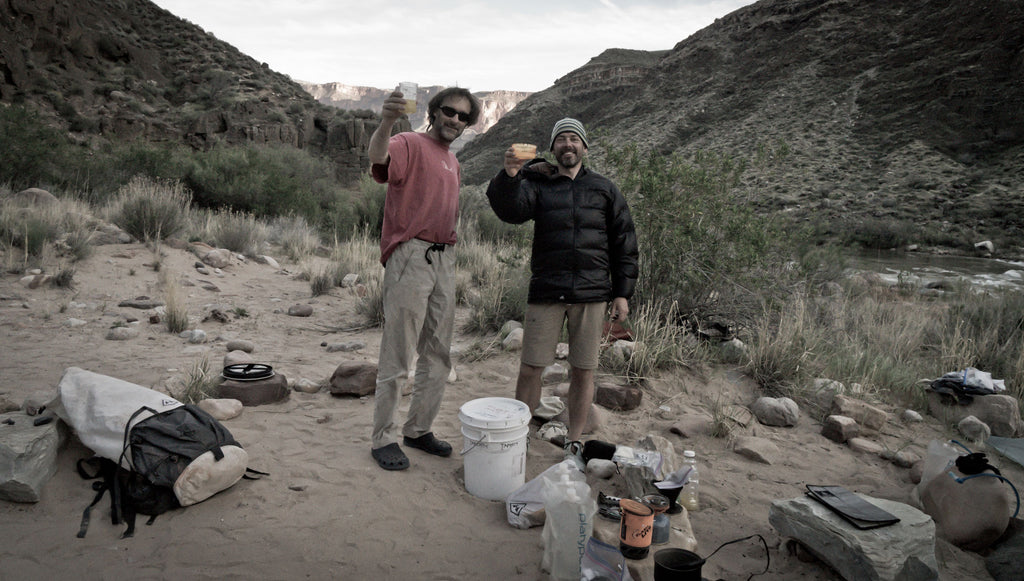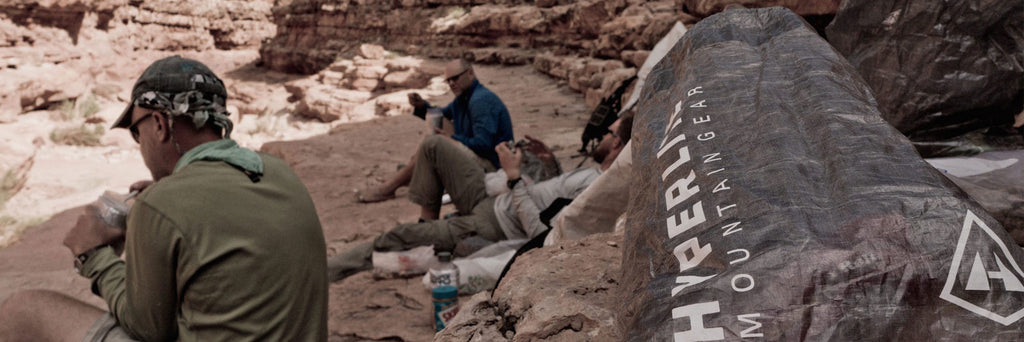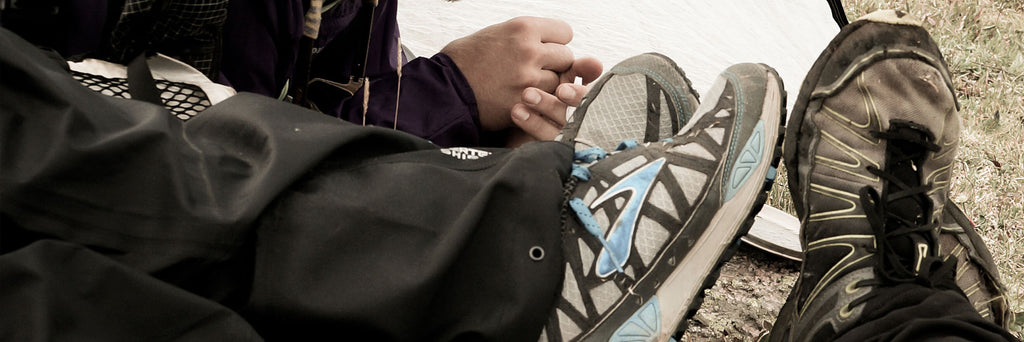Pack Discipline Starts Here: Stuff Sacks + Pods
April 26, 2018
Words & Photos by Mike St. Pierre
When you’re first learning the ins-and-outs of how to pack light for backpacking, it’s important to understand that it’s a process. I still constantly refine the gear I take on trips, and learn something new every time I pack my pack. That’s because I aspire to adhere to what I think is one of the most important precepts of ultralight backpacking, one I learned from Hyperlite Mountain Gear Ambassador Roman Dial. His philosophy is not just to buy and carry lighter stuff, but rather to travel as simply as possible and use gear for multiple purposes (you can read more about how another of our ambassadors, Forrest McCarthy, applies Roman’s ethic in our previous post, “The Soul of Minimalist Backpacking“).
Generally, the more skill and experience you have, the less gear you need. Similarly, the more information you gather pre-trip, the better prepared you’ll be when you set out. Know where you going and what you’re doing, and you’ll be able to choose exactly the right gear for the conditions (and leave behind what you don’t need). For example, if I’m going for an overnight trip in the fall in New England and the weather is clear, there won’t likely be bugs. So I might not need to bring a shelter, or I might take something very minimalist like a Flat Tarp. It’s a versatile option that can be pitched in an amazing number of configurations, and can also serve multiple purposes. It’s also very, very light (10 oz.).
When it comes to a gear list for a given trip, I carefully plan everything out to address the climate, time of year and all the different types of terrain. I make an excel spreadsheet and list out everything I think I’ll need. I then calculate the weights of everything and the calories per day I’ll need to carry that weight (and to stay warm and energized for the long miles we’ll be hiking).
That gets complicated pretty quickly, especially on longer, self-supported and or multi-discipline trips. On a recent section hike in the Grand Canyon, I knew I’d need to carry eight to ten days of food between resupply caches, plus at least 12 lbs. of backpacking gear, my camera, plus six lbs. of technical gear that my partner, Clay, and I would share. That would put us at 30 lbs. each. Throw the four to six liters of water we’d be require at any given time on top of that, and it looked like our packs would fluctuate between 25 and 50lbs throughout the duration of the trip. (If you’re interested in what the final gear list looked like, you can read more here: Long-Distance, Lightweight Thru Hiking Gear List (for the Grand Canyon).

Knowing that is half the battle. The 50-pound mark is a daunting one, especially in a harsh, technical environment where extreme temperatures are common. That’s why the next step is almost the most critical: We needed to shakedown our gear list to see if we could achieve any weight savings.
I easily replaced some heavy objects with lighter ones. I knew I needed to carry a harness but wouldn’t need to use it very often, so I researched new lighter options that might be on the market. I found a three oz. CAMP USA harness (The Alp Racing). I wouldn’t wear it for actual climbing at my local crag, but it would keep me safe scrambling up rocks in exposed areas and rappelling down slot canyons.
Other things that I lightened were not so obvious in the beginning of my planning stages. But as I started lightening up things like the harness, carabiners and rope, other items started to seem really heavy—like my down jacket and base layers.
It’s really easy to over-pack clothing, and clothes get heavy fast. This is where thorough pre-trip information gathering comes into play. I knew that the temperatures were going to vary wildly on this Grand Canyon section hike. My usual ultralight kit falls into the three-season range, but in March sections of the Grand Canyon can drop to 15-degrees with snow at the higher elevations. But at the same time, a heavy winter kit wouldn’t cut it because daytime temps can be 60 to 80 degrees.
That meant I had to have a puffy jacket and clothes that, paired with my sleeping system, could handle anything from 15- to 90-degree weather. So I looked for clothes that would work together in a system in a broader range of temperatures, but would have the same weight as my three-season garb.
With a little research, I found Luke’s Ultralight, a company that made me a 4oz. down vest and 6oz. jacket that were warmer than lighter than the jackets I’ve carried for years. I brought my lightweight 20-degree sleeping bag as well, knowing I could get through a few nights of 15-degree weather with all my layers and down on and still not feel beleaguered and weighted down when the mercury shot up to 80-plus degrees. Sure, I might spend a night or two curled deep in my bag counting the minutes until morning, but I wouldn’t become hypothermic. Those are trade offs I’m willing to make when it comes to planning.

I also looked for other solutions for base layers, and settled on trading up a few pieces so that I could wear the same shirt and shorts for nearly 30 days. I used just one super light Arc’Teryx’s Phase SL Crew ultralight base layer and one button down long sleeve synthetic shirt, in addition to quick-drying convertible pants. I was able to do “laundry” just three times on the trip, but that was enough. Besides, if you think clothes are heavy—try soap!
This was obviously a pretty extreme scenario—I don’t always agonize over every little thing I’m bringing on a trip. The Grand Canyon is a pretty extreme environment, though, and this might have been my most ambitious adventure ever. Fundamentally re-working systems is generally something I try to avoid, but sometimes it’s necessary.
The good news is that there has literally never been a better time to be a backpacker than right now. There are so many options, so many people manufacturing high-quality gear and figuring out how to continually do more with less stuff. I find it inspiring, but I understand that it can also be daunting if you’re just getting going.
If you’re just starting to learn how to pack light for backpacking, you don’t necessarily have to go to the extremes I did. The underlying methodology is what’s really important: Plan, organize, weigh, assess, re-consider, repeat until you’re satisfied that with the resources you have available, you’re going to have the best trip possible.
One thing is for sure: the more you work at it, the more optimized you, your gear and your trips will get.
That said, here are five quick steps anyone with any level of experience in the outdoors can take to lighten their load. Wherever you’re starting from, these tips are guaranteed to save some weight. If you like results, and have more fun on your next hike as a result, consider taking the next step and investing in further shaving off some weight. I may be biased, but a really lightweight weight pack that fits great is an excellent next step!
Nylon Stuff Sacks: Pull that sleeping pad out of the sack it came with and forget about it! Instead of rolling your pad up oh-so-tight and cramming it down into that thing (while your companions stand around and wait), you can just fold it up to the size of the back panel of your pack and slip down between you and your gear for extra cushioning. Same goes for awkwardly cramming your tent in that tight, tiny little stuff sack, especially on those cold, wet mornings when your fingers don’t want to work. Just ball it up and stash it at the bottom of your pack. It will not only lighten your load, but it will fill in empty spaces to make your pack feel more compact and push the rest of the bulk of the weight a little higher on your back, which is a good thing.
For scenarios where organization is critical and you can’t just leave a stuff sack at home, consider trading up to an ultralight stuff sack or two. Years ago, I dropped a pound by swapping out my roll-top and dry bag style sacks for my (then) homemade Cuben Fiber stuff sacks. Now, I like to use our Pods for my food, typically dividing meals into type (breakfast, lunch, and dinner) to make things easier at the end of the day when I’m hungry and tired, and fill in the rest of my organizational needs with our standard stuff sacks.

Hiking Boots: Whenever people ask me how to pack light for backpacking, this is one of the first things I say. You’ll expend less energy, have fewer blisters, and break in your new shoes faster by exchanging your big, burly hiking boots for trail runners. Most of the top ranked hiking boots on the market weigh between 2.5 and 4.5 pounds. The best trail running shoes are all well under two pounds. Plus, there’s little evidence behind the myth of big boots equal better ankle support. You’re better off following a consistent regimen of stretching and strengthening excises to prepare for hiking season in the first place. And finally, waterproof boots aren’t going to stay waterproof for long, so don’t bother. Trail running shoes dry out faster, too. I can’t remember the last time I took my shoes off to cross a river so as to not get them wet.

Ground Cloths: Leave those cheapo blue tarps at your local hardware store. Even if you cut it down it will likely weigh at least a couple pounds. Same goes for those rubberized things they sell at REI, Cabella’s and the other big box stores with 1,000 feet of edge binding and 1,000,000 grommets and buckles.
Some people turn instead to sheets of house wrap as a moisture barrier between them and the ground. There are a lot of products like this on the market today (Tyvek is just one of many), and not all are created equally. Some are much more waterproof than others, especially when it comes to laying a harm human body on a wide range of different temperature surfaces. We developed our Ground Cloth as a more durable alternative that’s also quieter to move around on once it’s broken in. It is truly a waterproof barrier between you and the ground and can also serve as a small shelter in a pinch, and weighs just 3.4oz. You’ll get years and years of use out them if you’re willing to make the addition investment.

Pole Straps and Baskets: Trekking poles will change your life. If you haven’t tried them, I hope my other article on how to use trekking poles to decrease fatigue and increase your speed and efficiency of movement will get you started. Once you’ve committed to the four-wheel drive (quadriped?) lifestyle, think about pulling off those pole straps and baskets. It may seem insignificant, but swinging those things around for hours on end will make you just that much more tired at the end of the day. You could save yourself up to a half a pound in the process. That’s not counting the additional weight you’ll save once you also start using your poles to pitch a shelter instead of a tent.
Knife: This one’s easy: Leave your hatchet, machete or Bowie knife at home, Davie Crockett. For anything other than skinning a mean ol’ bahr, a pocket knife should do. I carry a key chain knife that weighs about the same as my lip balm.
In the long run, dialing your ultralight backpacking gear list is a personal thing. You have to assess your needs, and figure out which of them fall more into the category of “wants.” That can take a while, and it’s also always changing. Sometimes you just know that you’re going to want something to sit on if the ground is cold and rain is forecast. Other times, the thrill of moving fast and light outweighs creature comforts.
It’s definitely one of those “journey is the destination” scenarios, but it’s one that I think is entirely worthwhile—as much in backpacking as in life in general. To go back to Roman’s guiding principle, learning to travel simply is about needing and wanting less. In the long run, getting dialed is good for you—mentally and physically—and helps to reduce the footprint your adventures leave on the planet in the long run.
The post Never Not Learning: How to Pack Light For Backpacking with Mike St. Pierre appeared first on Hyperlite Mountain Gear Blog.
YOUR CART IS EMPTY
Let’s find you the right gear for
your next adventure.